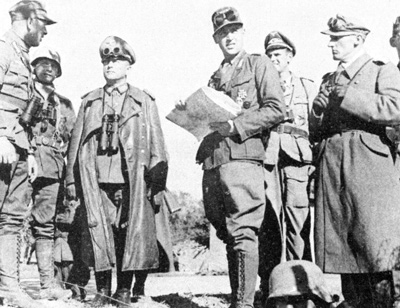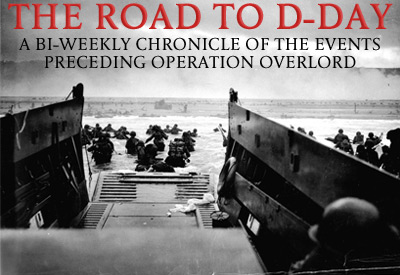Additional WWII Resources
Readers eager to learn more about the campaign in Western Europe, as well as the earlier struggles in the Mediterranean, have no shortage of resources from which to choose. A full array can be found in the Selected Sources at the back of The Guns at Last Light, just as extensive bibliographies can be found on the campaigns in Africa and Italy in, respectively, An Army at Dawn and The Day of Battle. Moreover, on the www.liberationtrilogy.com website, I have listed a number of manuscripts, monographs, and unpublished documents used as supplemental sources in volumes two and three which do not appear in the published bibliographies.
For a big-picture understanding of the global war, I recommend: Gerhard L. Weinberg, A World at Arms; Max Hastings, Inferno: The World at War, 1939-1945; Antony Beevor, The Second World War; Williamson Murray and Allan R. Millett, A War to Be Won; Chester Wilmot, The Struggle for Europe; and Richard Overy, Why the Allies Won. Perhaps the most vivid and tactile account of the war may be found in the National World War II Museum, in New Orleans. Over the past decade, the museum has vastly expanded its artifacts, pavilions, and archival holdings; it now offers a thorough, compelling experience about the war’s origins, campaigns, personalities, and consequences. For more information, visit the website at www.nationalww2museum.org.
Commendable works on the war in North Africa include: Correlli Barnett, The Desert Generals; Martin Blumenson, Kasserine Pass; David Fraser, Knight’s Cross: A Life of Field Marshal Erwin Rommel; Arthur Layton Funk, The Politics of Torch; Kent Roberts Greenfield, ed., Command Decisions; Nigel Hamilton, Master of the Battlefield: Monty’s War Years, 1942-1944; W.G.F. Jackson, The Battle for North Africa;
For insight into the campaigns in Sicily and Italy: Michael Howard, The Mediterranean Strategy in the Second World War; Carlo D’Este, Bitter Victory: The Battle for Sicily, July-August 1943 and Fatal Decision; Anzio and the Battle for Rome; John Ellis, Cassino: The Hollow Victory; Martin Blumenson, Bloody River; Mark Zuehlke, The Gothic Line; Mark W. Clark, Calculated Risk; Lucian K. Truscott, Jr., Command Missions; Ronald Lewin, Montgomery as Military Commander; Kenneth Macksey, Kesselring: The Making of the Luftwaffe; and Norman Lewis, Naples ’44.
In western Europe, for the Normandy invasion, noteworthy works include Antony Beevor D-Day; Carlo D’Este, Decision in Normandy; John Keegan Six Armies in Normandy; Olivier Wieviorka, Normandy; Stephen E. Ambrose, Pegasus Bridge, and Joseph Balkoski, Omaha Beach and Utah Beach.
Operation MARKET GARDEN is described fully in Martin Middlebrook, Arnhem 1944: Robert J. Kershaw, “It Never Snows in September”; Geoffrey Powell, The Devil’s Birthday; and Cornelius Ryan, A Bridge Too Far. Commendable works on the Battle of the Bulge include John S. D. Eisenhower, The Bitter Woods; Charles B. MacDonald, A Time for Trumpets; and Danny S. Parker, ed., The Battle of the Bulge: The German View.
Other works of note, either about particular campaigns or other aspects of the war in Europe, include Russell F. Weigley, Eisenhower’s Lieutenants; Andrew Roberts, Masters and Commanders; Mark A. Stoler, Allies and Adversaries; Charles F. Brower, ed., World War II in Europe: The Final Year; D. K. R. Crosswell, Beetle: The Life of General Walter Bedell Smith; Martin Blumenson, The Battle of the Generals; John Nelson Rickard, Patton at Bay: The Lorraine Campaign, 1944; Derek S. Zumbro, Battle for the Ruhr; John Toland, The Last Hundred Days; David Kahn, The Codebreakers; Eric Larrabee, Commander in Chief; S. M. Plokhy, Yalta: The Price of Peace; and Diane Shaver Clemens, Yalta. Fine books on the home front during the final year of the war include David M. Kennedy, Freedom From Fear; Doris Kearns Goodwin, No Ordinary Time, and David Reynolds, Rich Relations.
German perspectives on the war in the West can be gleaned from Joachim C. Fest, Hitler; Ian Kershaw, Hitler, 1936-45: Nemesis; Geoffrey P. Megargee, Inside Hitler’s High Command; Siegfried Westphal, The German Army in the West; Hans-Adolf Jacobsen and Jürgen Rohwer, eds., Decisive Battles of World War II: The German View; Frido von Senger und Etterlin, Neither Fear nor Hope; and Joachim Ludewig, Rückzug: The German Retreat from France, 1944.
For a broader understanding of the air war: Donald L. Miller, Masters of the Air; Tami Davis Biddle, Rhetoric and Reality in Air Warfare; Richard G. Davis, Carl A. Spaatz and the Air War in Europe; Conrad C. Crane, Bombs, Cities & Civilians; and Max Hastings, Bomber Command.
I rely more than most historians on the work of war correspondents, perhaps because I was one myself. Among my favorites: Osmar White, Conqueror’s Road; Alan Moorehead, Eclipse; Eric Sevareid, Not So Wild a Dream; R. W. Thompson, Men Under Fire; Ernie Pyle, Brave Men; W. C. Heinz, When We Were One; Iris Carpenter, No Woman’s World; Robert Capa, Slightly Out of Focus; A.J. Liebling, Mollie & Other Pieces; Don Whitehead, “Beachhead Don”; and Margaret Bourke-White, Purple Heart Valley. A good anthology can be found in Richard Collier, Fighting Words: The War Correspondents of World War Two.
Those who took part in the struggles between Normandy and Berlin wrote many enduring memoirs and meditations. To name a few worthy of note: Charles R. Cawthon, Other Clay; Forrest C. Pogue, Pogue’s War; Paul Fussell, Wartime; Bert Stiles, Serenade to the Big Bird; June Wandrey, Bedpan Commando; J. Lawton Collins, Lightning Joe; Harry C. Butcher, My Three Years With Eisenhower; Vernon Scannell, Argument of Kings; J. Glenn Gray, The Warriors; and Marshal De Lattre de Tassigny, The History of the French First Army.
I often hear from readers keen to learn more about a particular veteran or unit. A good place to start for the U.S. Army is the Military History Institute in Carlisle, Pennsylvania, at the Army Heritage and Education Center: http://www.carlisle.army.mil/ahec/. A comparable repository is the Air Force Historical Research Agency at Maxwell Air Force Base in Montgomery, Alabama: http://www.afhra.af.mil/. The U.S. Navy’s History and Heritage Command is in Washington, D.C.: http://www.history.navy.mil/. Official U.S. military records and photographs are kept in the National Archives at College Park, Maryland. To get some sense of what the Archives have to offer, visit http://www.archives.gov/.


